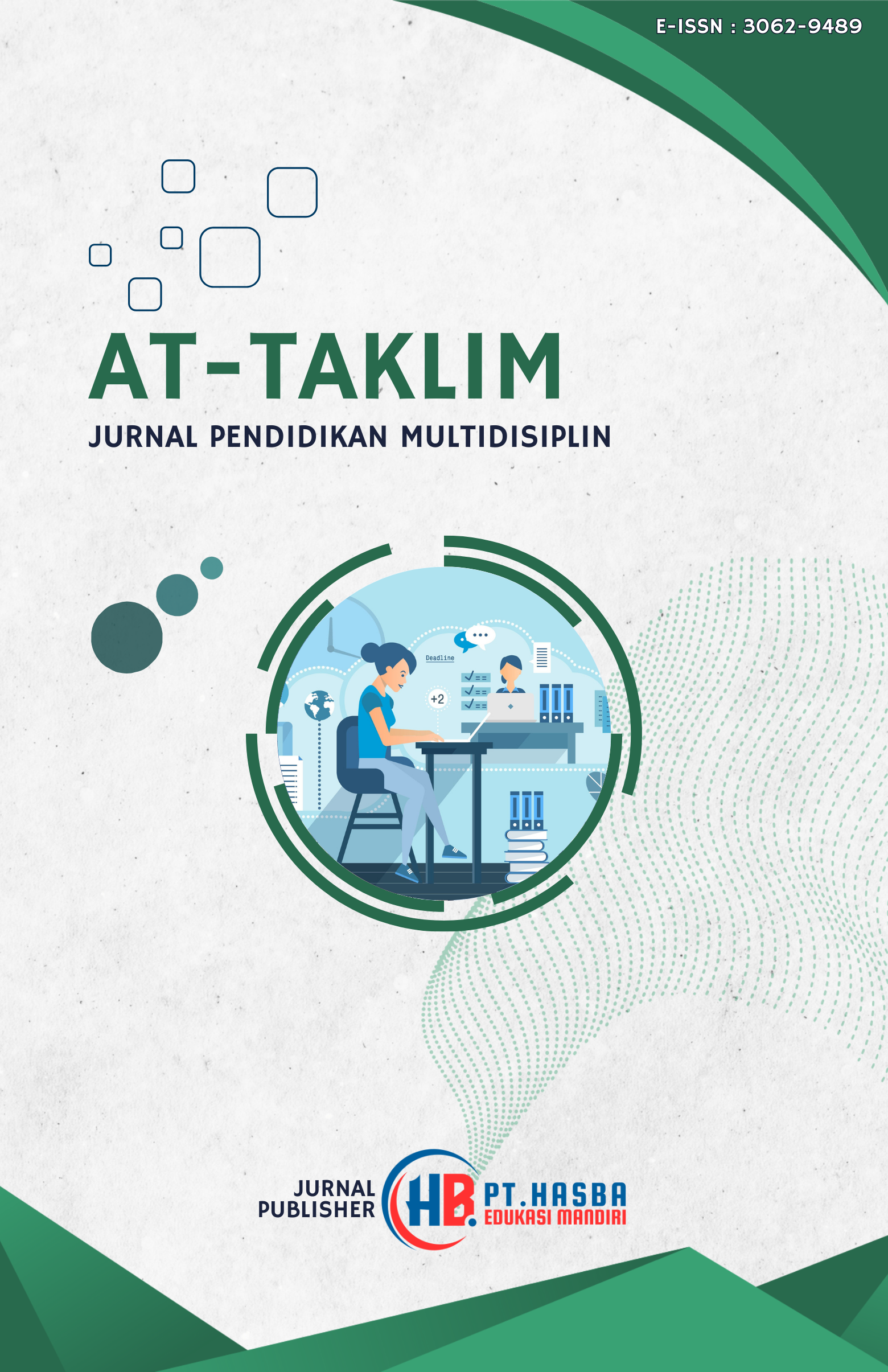The Relationship Between Duration of Type 2 Diabetes and HbA1C with the Incidence of Diabetic Ulcers in Diabetes Patients at Roemani Hospital
DOI:
https://doi.org/10.71282/at-taklim.v2i8.872Keywords:
Diabetes Mellitus, HbA1C, Diabetic UlcerAbstract
Background: Type 2 diabetes mellitus (DM) is a chronic disease that can cause various complications, one of which is diabetic ulcers. Long-term DM and poor glycemic control, as indicated by high HbA1C levels, are thought to contribute to the development of diabetic ulcers. Methods: This study employed an observational analysis approach with a cross-sectional design. The data collection method used total sampling, with 86 samples drawn from the total population. Analysis used the Spearman Rank test with a 95% confidence level and a margin of error of 0.05. Results: The majority of respondents were aged 40–60 years, with a duration of DM ≥5 years (73.3%), HbA1C >6.4% (75.6%), and grade 1 diabetic ulcers (26.7%). Spearman rank analysis results showed a significant relationship between the duration of type 2 DM and the incidence of diabetic ulcers (r = 0.267; p = 0.01) and a significant relationship between HbA1C and the incidence of diabetic ulcers (r = 0.482; p = 0.01). Conclusion: There is a relationship between the duration of type 2 DM and HbA1C with the incidence of diabetic ulcers in type 2 DM patients at Roemani Hospital
Downloads
References
Dewi N, Lay YU. Level of Knowledge and Self-Motivation in Preventing Diabetic Foot Ulcers in Elderly Patients with Type 2 Diabetes Mellitus. National Conference Update on Nursing. 2024;1(1):88-97.
Rizky A. Factors Associated with Diabetes Mellitus Prevention Behavior in Adolescents in Pedurungan District, Semarang City, Central Java. Journal of Comprehensive Science. 2024;3(2):348-366.
Kurniawan AE, Fatmariza AR. Differences in Interleukin-6 Levels in Patients with Controlled and Uncontrolled Type 2 Diabetes Mellitus. Jk: Jurnal Kesehatan. 2024;2(4):262-268.
Octaviani ZM, Indriyanti RA, Damayanti MM. Characteristics of Type 2 Diabetes Mellitus Patients with Diabetic Ulcer Complications at Al-Ihsan Hospital in 2022. Bandung Conference Series: Medical Science. 2024;4(1):810-816.
Sihombing JR, Margareta E. Analysis of Hba1c Levels in Type 2 Diabetes Mellitus Patients at Martha Friska Multatuli Hospital, Medan. 2017;2(2):422-433.
Wang K, Wang Y, Shi W, Shen K, Tao K, Ling R, et al. Diagnosis and treatment of diabetic foot ulcer complicated with lower extremity vasculopathy: Consensus recommendation from the Chinese Medical Association (CMA), Chinese Medical Doctor Association (CMDA). Diabetes Metab Res Rev. 25 Maret 2024;40(3).
Sriyati. Diabetic Neuropathy as a Predisposing Factor for Foot Wounds. Scientific Journal of Yarsi Mataram Health Sciences College. 2024;14(1):46-52.
Trisnawati, Anggraini RB, Nurvinanda R. Factors Associated with the Occurrence of Diabetic Ulcers in Patients with Diabetes Mellitus. Indonesian Journal of Nursing and Health Sciences. 2023;4(2):85-94.
Wahyuni S. Relationship Between Age And Gender And Degree Of Diabetic Foot Wounds In Dm Patients In Makassar City. Healthy Tadulako Journal (Tadulako Health Journal). 2023;9(2):194–198.
Zhang ZY, Miao L. Molecular Mechanisms of Glucose Fluctuations on Diabetic Complications. Frontiers in Endocrinology. 2019;10:1-11.
Hu Y ming, Zhao L hua, Zhang X lin, Cai H li. Association of glycaemic variability evaluated by continuous glucose monitoring with diabetic peripheral neuropathy in type 2 diabetic patients. Endocrine. 6 Mei 2018;60(2):292–300.
Fikri EA, Sulistyani S, Setiawan I, Puspitasari M. The Relationship Between Hba1c Levels and Age with the Incidence of Diabetic Neuropathy in Diabetes Mellitus Patients. Jurnal Ilmiah Permas: Jurnal Ilmiah Stikes Kendal. 2024;14(3):1027-1034.
Sherwani SI, Khan HA, Ekhzaimy A, Masood A, Sakharkar MK. Significance of HbA1c test in diagnosis and prognosis of diabetic patients. Libertas Academica. 2016;11:95–104.
Raharjo MA, Fajari NM. Correlation of Neutrophil-Lymphocyte Ratio with the Severity of Diabetic Foot at the Diabetic Foot Clinic of Ulin Regional Hospital, Banjarmasin. 2020;3(3):467-476.
Yazdanpanah L. Literature review on the management of diabetic foot ulcer. World J Diabetes. 2015;6(1):37.
Sitompul MS, Tarigan B. The Relationship of Predictor Factors (Hb, Leukocytes, Platelets, LDL, Hba1c, D-Dimer, Albumin) to the Severity of Diabetic Ulcer Patients at Dr. Pirngadi Regional Hospital, Medan City, 2022-2023. Medical Journal (Medimeth). 2025;3(1):1-12.
Oktalia AW, Retnaningrum YR, Khotimah S. The Relationship Between Peripheral Artery Disease and Hba1c Levels with Extremity Amputation in Diabetic Foot Ulcer Patients at Abdul Wahab Sjahranie Regional Hospital, Samarinda. Journal of Science and Health. 2021;3(5):715–21.
Umami RT, Angraini H, Nuroini F, Studi P. Relation between Blood Glucose Level and HbA1c in Diabetic Ulcers. 2018;1:297-301.
Downloads
Published
Issue
Section
License
Copyright (c) 2025 Ali Ridwan Rohmatullah, Alif Adlan Zulizar, Rifka Widianingrum (Author)

This work is licensed under a Creative Commons Attribution-ShareAlike 4.0 International License.













